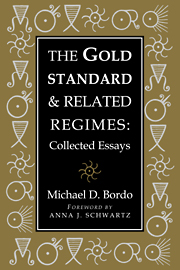Book contents
- Frontmatter
- Contents
- Foreword
- 1 The Gold Standard and Related Regimes: Introduction to the Collection
- Part I History of Doctrine and the Gold Standard
- Part II The Gold Standard as a Commodity Standard
- 5 The Classical Gold Standard: Some Lessons for Today
- 6 A Model of the Classical Gold Standard with Depletion
- Part III The Gold Standard as a Contingent Rule
- Part IV Historical Case Studies
- Part V The Bretton Woods International Monetary System
- Index
- Titles in the series
6 - A Model of the Classical Gold Standard with Depletion
Published online by Cambridge University Press: 19 October 2009
- Frontmatter
- Contents
- Foreword
- 1 The Gold Standard and Related Regimes: Introduction to the Collection
- Part I History of Doctrine and the Gold Standard
- Part II The Gold Standard as a Commodity Standard
- 5 The Classical Gold Standard: Some Lessons for Today
- 6 A Model of the Classical Gold Standard with Depletion
- Part III The Gold Standard as a Contingent Rule
- Part IV Historical Case Studies
- Part V The Bretton Woods International Monetary System
- Index
- Titles in the series
Summary
The operation and properties of the classical gold standard are well recognized. However, one aspect that has not been dealt with is that gold has the characteristics of a durable, but depletable resource. In this chapter, we compare the simple classical model of the gold standard with a model of the gold standard that incorporates the durable, depletable nature of gold. Using numerical simulation techniques, we demonstrate an inescapable tendency to long-run deflation when account is taken of the resource constraint. These results are consistent, with and without technological progress and variable real rates of return.
Introduction
Recent dissatisfaction with high rates of inflation and real economic instability in the U.S. and elsewhere has led to criticism of the operation of the present fiat-based monetary system. Some economists have advocated a return to the classical gold standard, based on a government maintained fixed price of gold in terms of the national currency, on the grounds that the gold standard would provide greater price stability than under current arrangement. Indeed, such interest led to the establishment of the U.S. Congressional Gold Commission in 1981.
A second desirable attribute of the gold standard stressed by its advocates is that the monetary gold stock and hence the money supply is determined by competitive market forces according to the classical commodity theory of money largely independent of government policy. The classical tradition of Thornton (1802), Mill (1865), Fisher (1922), and Friedman (1953) viewed the monetary gold stock and hence the money supply and the price level under the gold standard as determined by two offsetting sets of equilibrating forces producing a tendency to long-run price stability:
- Type
- Chapter
- Information
- The Gold Standard and Related RegimesCollected Essays, pp. 179 - 192Publisher: Cambridge University PressPrint publication year: 1999



